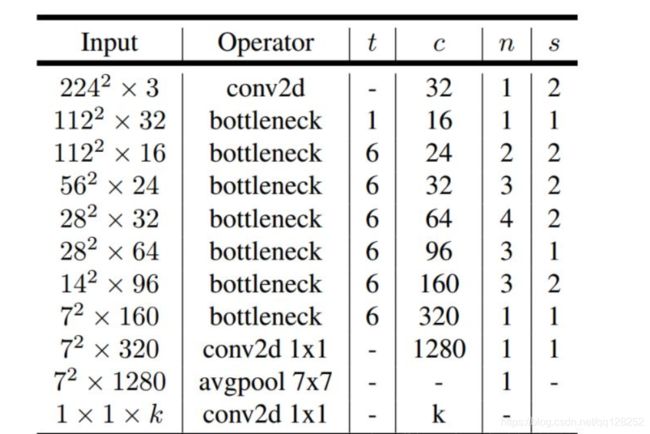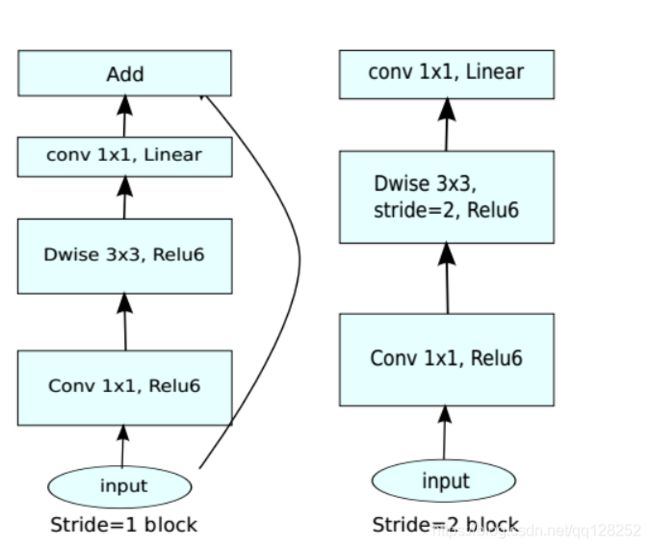MobileNetV2详细总结以及代码讲解
MobileNetV2
- 模型介绍
-
- 模型网络
-
- 代码实现+图片预测
模型介绍
特点:1.相比于MobileNetV1,先进行了1x1的卷积进行升维,目的在于获得更多特征,然后用3x3的空间卷积,最后再用1x1降维。核心思想是升维再降维,参数量更少。
2.为了避免Relu对特征的破坏,在在3x3网络结构前利用1x1卷积升维,在3x3网络结构后,再利用1x1卷积降维后,不再进行Relu6层,直接进行残差网络的加法。
PS:Relu对于负的输入,输出全为零;而本来特征就已经被“压缩”,再经过Relu的话,又要“损失”一部分特征,因此这里不采用Relu。
模型网络
t:1x1升维扩张的倍数。
c:输出通道数。
n:进行多少次。
s:步长。

如下图是bottleneck的结构,这里我们需要注意的是,步长维1和2的情况是不同的。stride=2时,不采用shortcut。因为维度变化,无法相加。

代码实现+图片预测
我们先将代码块分开说明。
首先,我们来看一下MoblieNet的更新点吧。
从上面我们知道:
1. (1,1)的pointwise卷积,提高通道数,结果Relu
2. (3,3)的depthwise卷积,提特征,结果Relu
3. (1,1)的pointwise卷积,单纯降维,不Relu
4.输入与输出的shortcut
所以在步长(2,2)的时候,要注意使用correct_pad填充特征图,
避免卷积出小数宽高特征图的情况。
这就是第一步啦,1x1扩张,relu6。
if block_id:
# Expand
x = layers.Conv2D(expansion * in_channels,
kernel_size=1,
padding='same',
use_bias=False,
activation=None,
name=prefix + 'expand')(x)
x = layers.BatchNormalization(axis=channel_axis,
epsilon=1e-3,
momentum=0.999,
name=prefix + 'expand_BN')(x)
x = layers.ReLU(6., name=prefix + 'expand_relu')(x)
else:
prefix = 'expanded_conv_'
在这里我们进行填充0的操作,为的是在3x3卷积后,长宽缩短到1/2,correct_pad是计算padding。
if stride == 2:
x = ZeroPadding2D(padding=correct_pad(x, 3),
name=prefix + 'pad')(x)
然后就是可分离卷积了。
# part2 可分离卷积
x = DepthwiseConv2D(kernel_size=3,
strides=stride,
activation=None,
use_bias=False,
padding='same' if stride == 1 else 'valid',
name=prefix + 'depthwise')(x)
x = BatchNormalization(epsilon=1e-3,
momentum=0.999,
name=prefix + 'depthwise_BN')(x)
x = Activation(relu6, name=prefix + 'depthwise_relu')(x)
最后就是进行降维,这里不用relu。当stride=1以及输入输出通道数相同时,进行shortcut。
# part3压缩特征,而且不使用relu函数,保证特征不被破坏
x = Conv2D(pointwise_filters,
kernel_size=1,
padding='same',
use_bias=False,
activation=None,
name=prefix + 'project')(x)
x = BatchNormalization(epsilon=1e-3,
momentum=0.999,
name=prefix + 'project_BN')(x)
if in_channels == pointwise_filters and stride == 1:
return Add(name=prefix + 'add')([inputs, x])
return x
下面是代码整合
#-------------------------------------------------------------#
# MobileNetV2的网络部分
#-------------------------------------------------------------#
import math
import numpy as np
import tensorflow as tf
from tensorflow.keras import backend
from keras import backend as K
from keras.preprocessing import image
from keras.models import Model
from keras.layers.normalization import BatchNormalization
from keras.layers import Conv2D, Add, ZeroPadding2D, GlobalAveragePooling2D, Dropout, Dense
from keras.layers import MaxPooling2D,Activation,DepthwiseConv2D,Input,GlobalMaxPooling2D
from keras.applications import imagenet_utils
from keras.applications.imagenet_utils import decode_predictions
from keras.utils.data_utils import get_file
# TODO Change path to v1.1
BASE_WEIGHT_PATH = ('https://github.com/JonathanCMitchell/mobilenet_v2_keras/'
'releases/download/v1.1/')
# relu6!
def relu6(x):
return K.relu(x, max_value=6)
# 用于计算padding的大小
def correct_pad(inputs, kernel_size):
img_dim = 1
input_size = backend.int_shape(inputs)[img_dim:(img_dim + 2)]
if isinstance(kernel_size, int):
kernel_size = (kernel_size, kernel_size)
if input_size[0] is None:
adjust = (1, 1)
else:
adjust = (1 - input_size[0] % 2, 1 - input_size[1] % 2)
correct = (kernel_size[0] // 2, kernel_size[1] // 2)
return ((correct[0] - adjust[0], correct[0]),
(correct[1] - adjust[1], correct[1]))
# 使其结果可以被8整除,因为使用到了膨胀系数α
def _make_divisible(v, divisor, min_value=None):
if min_value is None:
min_value = divisor
new_v = max(min_value, int(v + divisor / 2) // divisor * divisor)
if new_v < 0.9 * v:
new_v += divisor
return new_v
def MobileNetV2(input_shape=[224,224,3],
alpha=1.0,
include_top=True,
weights='imagenet',
classes=1000):
rows = input_shape[0]
img_input = Input(shape=input_shape)
# stem部分
# 224,224,3 -> 112,112,32
first_block_filters = _make_divisible(32 * alpha, 8)
x = ZeroPadding2D(padding=correct_pad(img_input, 3),
name='Conv1_pad')(img_input)
x = Conv2D(first_block_filters,
kernel_size=3,
strides=(2, 2),
padding='valid',
use_bias=False,
name='Conv1')(x)
x = BatchNormalization(epsilon=1e-3,
momentum=0.999,
name='bn_Conv1')(x)
x = Activation(relu6, name='Conv1_relu')(x)
# 112,112,32 -> 112,112,16
x = _inverted_res_block(x, filters=16, alpha=alpha, stride=1,
expansion=1, block_id=0)
# 112,112,16 -> 56,56,24
x = _inverted_res_block(x, filters=24, alpha=alpha, stride=2,
expansion=6, block_id=1)
x = _inverted_res_block(x, filters=24, alpha=alpha, stride=1,
expansion=6, block_id=2)
# 56,56,24 -> 28,28,32
x = _inverted_res_block(x, filters=32, alpha=alpha, stride=2,
expansion=6, block_id=3)
x = _inverted_res_block(x, filters=32, alpha=alpha, stride=1,
expansion=6, block_id=4)
x = _inverted_res_block(x, filters=32, alpha=alpha, stride=1,
expansion=6, block_id=5)
# 28,28,32 -> 14,14,64
x = _inverted_res_block(x, filters=64, alpha=alpha, stride=2,
expansion=6, block_id=6)
x = _inverted_res_block(x, filters=64, alpha=alpha, stride=1,
expansion=6, block_id=7)
x = _inverted_res_block(x, filters=64, alpha=alpha, stride=1,
expansion=6, block_id=8)
x = _inverted_res_block(x, filters=64, alpha=alpha, stride=1,
expansion=6, block_id=9)
# 14,14,64 -> 14,14,96
x = _inverted_res_block(x, filters=96, alpha=alpha, stride=1,
expansion=6, block_id=10)
x = _inverted_res_block(x, filters=96, alpha=alpha, stride=1,
expansion=6, block_id=11)
x = _inverted_res_block(x, filters=96, alpha=alpha, stride=1,
expansion=6, block_id=12)
# 14,14,96 -> 7,7,160
x = _inverted_res_block(x, filters=160, alpha=alpha, stride=2,
expansion=6, block_id=13)
x = _inverted_res_block(x, filters=160, alpha=alpha, stride=1,
expansion=6, block_id=14)
x = _inverted_res_block(x, filters=160, alpha=alpha, stride=1,
expansion=6, block_id=15)
# 7,7,160 -> 7,7,320
x = _inverted_res_block(x, filters=320, alpha=alpha, stride=1,
expansion=6, block_id=16)
if alpha > 1.0:
last_block_filters = _make_divisible(1280 * alpha, 8)
else:
last_block_filters = 1280
# 7,7,320 -> 7,7,1280
x = Conv2D(last_block_filters,
kernel_size=1,
use_bias=False,
name='Conv_1')(x)
x = BatchNormalization(epsilon=1e-3,
momentum=0.999,
name='Conv_1_bn')(x)
x = Activation(relu6, name='out_relu')(x)
x = GlobalAveragePooling2D()(x)
x = Dense(classes, activation='softmax',
use_bias=True, name='Logits')(x)
inputs = img_input
model = Model(inputs, x, name='mobilenetv2_%0.2f_%s' % (alpha, rows))
# Load weights.
if weights == 'imagenet':
if include_top:
model_name = ('mobilenet_v2_weights_tf_dim_ordering_tf_kernels_' +
str(alpha) + '_' + str(rows) + '.h5')
weight_path = BASE_WEIGHT_PATH + model_name
weights_path = get_file(
model_name, weight_path, cache_subdir='models')
else:
model_name = ('mobilenet_v2_weights_tf_dim_ordering_tf_kernels_' +
str(alpha) + '_' + str(rows) + '_no_top' + '.h5')
weight_path = BASE_WEIGHT_PATH + model_name
weights_path = get_file(
model_name, weight_path, cache_subdir='models')
model.load_weights(weights_path)
elif weights is not None:
model.load_weights(weights)
return model
def _inverted_res_block(inputs, expansion, stride, alpha, filters, block_id):
in_channels = backend.int_shape(inputs)[-1]
pointwise_conv_filters = int(filters * alpha)
pointwise_filters = _make_divisible(pointwise_conv_filters, 8)
x = inputs
prefix = 'block_{}_'.format(block_id)
# part1 数据扩张
if block_id:
# Expand
x = Conv2D(expansion * in_channels,
kernel_size=1,
padding='same',
use_bias=False,
activation=None,
name=prefix + 'expand')(x)
x = BatchNormalization(epsilon=1e-3,
momentum=0.999,
name=prefix + 'expand_BN')(x)
x = Activation(relu6, name=prefix + 'expand_relu')(x)
else:
prefix = 'expanded_conv_'
if stride == 2:
x = ZeroPadding2D(padding=correct_pad(x, 3),
name=prefix + 'pad')(x)
# part2 可分离卷积
x = DepthwiseConv2D(kernel_size=3,
strides=stride,
activation=None,
use_bias=False,
padding='same' if stride == 1 else 'valid',
name=prefix + 'depthwise')(x)
x = BatchNormalization(epsilon=1e-3,
momentum=0.999,
name=prefix + 'depthwise_BN')(x)
x = Activation(relu6, name=prefix + 'depthwise_relu')(x)
# part3压缩特征,而且不使用relu函数,保证特征不被破坏
x = Conv2D(pointwise_filters,
kernel_size=1,
padding='same',
use_bias=False,
activation=None,
name=prefix + 'project')(x)
x = BatchNormalization(epsilon=1e-3,
momentum=0.999,
name=prefix + 'project_BN')(x)
if in_channels == pointwise_filters and stride == 1:
return Add(name=prefix + 'add')([inputs, x])
return x
def preprocess_input(x):
x /= 255.
x -= 0.5
x *= 2.
return x
if __name__ == '__main__':
model = MobileNetV2(input_shape=(224, 224, 3))
model.summary()
img_path = 'elephant.jpg'
img = image.load_img(img_path, target_size=(224, 224))
x = image.img_to_array(img)
x = np.expand_dims(x, axis=0)
x = preprocess_input(x)
print('Input image shape:', x.shape)
preds = model.predict(x)
print(np.argmax(preds))
print('Predicted:', decode_predictions(preds, 1))
